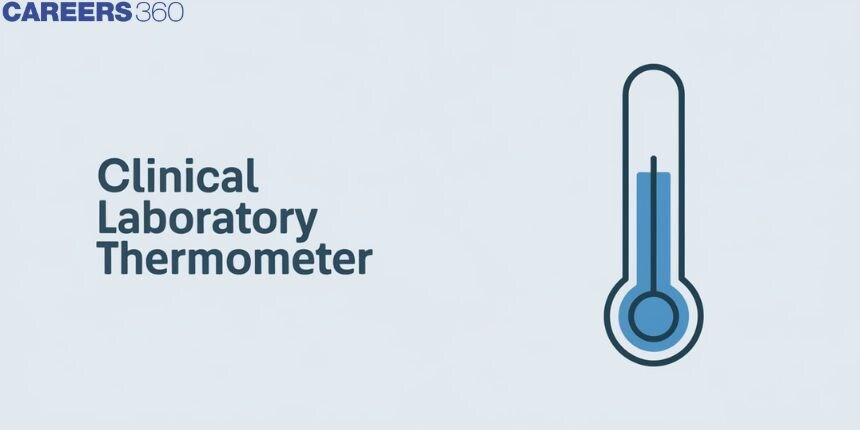Clinical Laboratory Thermometer - How to Use, Types, FAQs
A thermometer is a device used to measure temperature, which tells us how hot or cold an object is. We often get confused between heat and temperature, but they are different. Heat is a form of energy, while temperature shows the level of hotness or coldness of an object. If an object has more heat, its temperature is usually higher. To know how hot or cold something is, we use a thermometer. Thermometers are used in our daily life, such as checking body temperature when we are sick, and also in science laboratories. Learning about thermometers helps us understand temperature clearly.
This Story also Contains
- What is a thermometer?
- Different Types of Thermometers
- Clinical Thermometer
- Digital Thermometer
- Infrared Ear Thermometer

What is a thermometer?
A thermometer is a device used to measure the temperature of a body or object. Temperature tells us how hot or cold something is. Thermometers are widely used in daily life, medical science, laboratories, industries, and research. They work by sensing temperature changes and converting them into readable values, either through a scale or a digital display.
NCERT Physics Notes :
Different Types of Thermometers
Our daily thermometers come in a variety of shapes, sizes, and materials:
-
Clinical thermometer
-
Laboratory thermometer
-
Digital thermometer
-
Infrared ear thermometer
-
Mercury thermometer
-
Alcohol in glass thermometer
-
Constant pressure gas thermometer
-
Constant volume thermometer
-
Platinum resistance thermometer
-
Thermocouple thermometer
-
Pyrometer thermometer
Also read -
Clinical Thermometer
A clinical thermometer is specially designed to measure the human body temperature. It is commonly used in hospitals, clinics, and homes. A traditional clinical thermometer consists of a narrow glass tube with a mercury bulb at one end.
Range of Clinical Thermometer
- $35^{\circ} \mathrm{C}$ to $\mathbf{4 2}^{\circ} \mathrm{C}$
- Normal body temperature: $\mathbf{3 7}^{\boldsymbol{\circ}} \mathbf{C}$
The mercury level rises or falls according to body temperature and gives an accurate reading. Due to the toxic nature of mercury, clinical thermometers are now mostly replaced by digital thermometers, which are safer and easier to use.
Clinical thermometer

Laboratory Thermometer:
A laboratory thermometer is used to measure the temperature of substances in laboratories, such as liquids, chemicals, and solutions. It is not used to measure body temperature. A laboratory thermometer usually consists of a long glass tube with a bulb containing mercury or alcohol.
- Temperature range: –10°C to 110°C
- Used to measure boiling point, freezing point, and reaction temperatures
- Does not have a kink, so the reading must be taken while the thermometer is kept in the substance
- Commonly used in school and college science laboratories
Laboratory thermometers are important for experiments and practical exams and help in accurate temperature measurement of non-living substances.
Digital Thermometer
A digital thermometer measures temperature using an electronic circuit. The temperature information is sensed and sent to a microchip, which processes the data and shows the reading in numbers on a digital display. Digital thermometers are easy to use, inexpensive, safe, and accurate, making them widely used for measuring body temperature. They are considered more advanced than mercury thermometers.
How to Use a Digital Thermometer
- Switch on the thermometer and wait until zero appears on the screen.
- Place the tip of the thermometer under the armpit.
- Wait for a few seconds until the beep sound is heard.
- Remove the thermometer and read the temperature.
- Clean the tip with cotton and alcohol after use.
Infrared Ear Thermometer
An infrared ear thermometer measures body temperature from inside the ear, known as tympanic membrane temperature. It is commonly used for children because it gives quick results. The thermometer detects infrared radiation emitted by the body.
How to Use an Infrared Ear Thermometer
- Place the tip gently inside the ear, pointing towards the nose.
- Press the power button until a signal is heard.
- Note the temperature reading on the display.
- Remove and clean the tip with cotton and alcohol.
- Do not use it if the ear has excess wax.
Also, check-
Frequently Asked Questions (FAQs)
As the inventor of the thermometer, Daniel Gabriel Fahrenheit is credited with inventing it. His life was devoted to research and technology. Fahrenheit is credited with the invention of the mercury thermometer, which is widely used today. The mercury-in-glass thermometer is also credited to him.
Alcohol's thermometer properties include the following:
It is recommended that the freezing point is less than -112°C.
The boiling point should be established at 78 degrees celsius.
It's important that the alcohol has a brilliant colour.
A suitable heat-insulator should be included.
It should be possible to measure high temperatures.
For a thermometer to be accurate, it must be inserted into cold water so that the stem is at least one inch deep without contacting the glass. Wait for a minute or less for the thermometer to register the ice water temperature. If the thermometer reads 32°F or 0°C, then it is said to be accurate.
When mercury is heated to room temperature, it turns into a liquid and has the highest coefficient of expansion of any element. Because of this, even the slightest variation in temperature can have a significant impact on the environment. Defined by its boiling point, mercury can also be used to measure very high temperatures. Because mercury does not adhere to the glass surface and has a shiny look, it is also used in thermometers.
When a patient's body temperature is being measured, a thermometer is placed in their mouth. A specific amount of mercury begins to flow via a thin capillary thread at a certain temperature as the mercury in the glass bulb heats up.